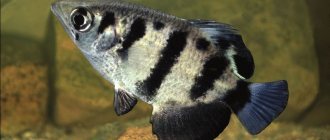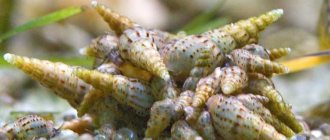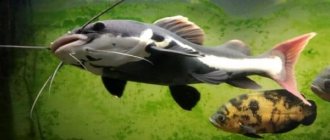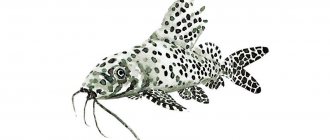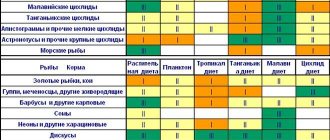Methods for quickly killing fish
The easiest and simplest way to stun is to hit the top of the head with a stick.
Avid fishermen prepare small clubs like a rolling pin for this purpose. You need to calculate the force of the impact correctly so that the fish dies instantly, but at the same time you need to try not to crush its head. The next method is suitable for small fish - their heads are sharply and strongly bent towards the back so that a crunch is heard. The easiest way to do this with a toothless fish is to stick your thumb in its mouth, so your hand won't slip off. After this, you need to cut the ridge just behind the head.
Large fish, such as pike, are first stunned by hitting them on the head, and then the upper vertebra is pierced with a sharp knife. For particularly large fish, you need to take a strong knife, otherwise you risk breaking it.
These options do not apply to flounder; its head is instantly cut off while holding it sideways.
Fish such as pike perch, ruffe, and perch are held tightly and quickly drawn with a sharp knife from head to tail. In this case, you need to press the gill wings and the dorsal fin. In this case, blood quickly drains from the fish. The only inconvenience with this method is that this carcass is not easy to cut into pieces or fillets, or remove the skin from it.
In the end, you can simply place the fish in the freezer, where it will quickly and reliably go to sleep. Experienced fishermen advise diluting a strong salt solution in a bucket of water into which you can dip the caught fish.
| 2021-11-28 The Astrakhan base is being checked for the mass shooting of ducks. An inspection has been initiated in Astrakhan for violation of the rules of amateur hunting. A photo appeared on the social network page of one of the recreation centers with a large number of... Read more » |
| 2021-09-24 More than 200 tons of red fish were caught in Primorye Primorye fishermen caught 134 tons of chum salmon and 92 tons of pink salmon. Salmon fishing is carried out in Terneysky, Lazovsky districts, and Olginsky district. Read more » |
| Search by map |
| Central Federal District (center - Moscow) Belgorod region(2) | Bryansk region(14) |
| Vladimir region(42) | Voronezh region(6) |
| Ivanovo region(20) | Kaluga region(63) |
| Kostroma region(12) | Kursk region(19) |
| Lipetsk region(3) | Moscow region(262) |
| Oryol region(4) | Ryazan region(27) |
| Smolensk region(50) | Tambov region(7) |
| Tver region(171) | Tula region(23) |
| Yaroslavl region(68) | Moscow city(5) |
Northwestern Federal District (center - St. Petersburg)
| Arkhangelsk region(19) | Vologda region(44) |
| Kaliningrad region(9) | Republic of Karelia(251) |
| Komi Republic(5) | Leningrad region(154) |
| Murmansk region(49) | Nenets Autonomous Okrug(7) |
| Novgorod region(47) | Pskov region(29) |
| City of St. Petersburg(1) |
Southern Federal District (center - Rostov-on-Don)
| Republic of Adygea(2) | Astrakhan region(353) |
| Volgograd region(44) | Republic of Dagestan(1) |
| Kabardino-Balkarian Republic(1) | Republic of Kalmykia(5) |
| Karachay-Cherkess Republic(3) | Krasnodar region(181) |
| Rostov region(38) | Stavropol Territory(4) |
Volga Federal District (center - Nizhny Novgorod)
| Republic of Bashkortostan(12) | Kirov region(11) |
| Republic of Mari El(7) | Republic of Mordovia(2) |
| Nizhny Novgorod region(37) | Orenburg region(28) |
| Penza region(10) | Perm region(35) |
| Samara region(52) | Republic of Tatarstan(10) |
| Udmurt Republic(17) | Ulyanovsk region(8) |
| Chuvash Republic(4) | Saratov region(21) |
Ural Federal District (center - Yekaterinburg)
| Kurgan region(9) | Sverdlovsk region(39) |
| Tyumen region(6) | Khanty-Mansiysk Autonomous Okrug - Yugra(20) |
| Chelyabinsk region(163) | Yamalo-Nenets Autonomous Okrug(3) |
Siberian Federal District (center - Novosibirsk)
| Altai Republic(23) | Altai Territory(25) |
| Republic of Buryatia(17) | Irkutsk region(48) |
| Kemerovo region(2) | Krasnoyarsk region(40) |
| Novosibirsk region(26) | Omsk region(6) |
| Tomsk region(27) | Republic of Tyva(3) |
| Republic of Khakassia(10) | Chita region(6) |
Far Eastern Federal District (center - Khabarovsk)
| Amur region(1) | Kamchatka region(36) |
| Primorsky Krai(21) | Sakhalin region(9) |
| Khabarovsk Territory(18) | Republic of Sakha (Yakutia)(14) |
Crimean Federal District (center - Simferopol)
| Republic of Crimea(6) | City of Sevastopol(2) |
| Popular regions |
| Astrakhan region (353) Moscow region (262) Republic of Karelia (251) Krasnodar region (181) Tver region (171) Chelyabinsk region (163) Leningrad region (154) Yaroslavl region (68) Kaluga region (63) Samara region (52) |
| Tel: +7-915-296-34-87 Victor, Whatsapp: +7-926-346-43-31 | View on map Add to favorites |
| Tel: (astro.), (Moscow) Carp (Carp) Bream Roach Catfish Pike perch | View on map Add to favorites |
| Tel: booking, manager in Slantsy | View on map Add to favorites |
| Tel: 8-921-014-92-44 | View on map Add to favorites |
| Tel: , | View on map Add to favorites |
| Tel: + Sergei, Evgeniy, manager Tyushkevich Evgeniy, senior. | View on map Add to favorites |
| Tel: In Moscow, in Astrakhan (8514) 596-555, | View on map Add to favorites |
| Krasnodar region / Kiyashkin estuary, Starominskaya Hunting Goose Raccoon Brown hare Wild boar Sandpiper Fox Quail Duck Pheasant Fishing Crucian Carp (Carp) Rudd Perch Roach Pike-perch Pike-perch Taran Silver carp Pike Recreation Excursions | View on map Add to favorites |
| Tel: ,, fax: 8814-393-83-15 | View on map Add to favorites |
| Tel: on the lake, (812) 715-48-67, (812) 92-4444-3 Crucian Carp (Carp) Bream Tench Perch Sturgeon Roach Whitefish White Trout Pike | Paid fishing View on map Add to favorites |
Our site is dedicated to fishing and hunting bases, fishing bases, hunting bases and hunting grounds. The most complete information in RuNet on hunting and fishing bases and hunting grounds in Russia. Map of hunting grounds for all regions of Russia, map of reservoirs. Also on our website there are reservoirs where paid fishing and spearfishing are possible. The most popular fishing places are the Astrakhan region, fishing in the Moscow region, fishing on Seliger, fishing on the Volga, fishing on Akhtuba, fishing on the Oka, fishing in the Leningrad region, fishing in Karelia, the Rybinsk Reservoir. There are a lot of reviews from visitors to the databases on our website. We have many articles about hunting, fishing, winter fishing, summer fishing, spearfishing, about fishing gear, spinning rods, fishing rods, inflatable boats, hunting weapons, hunting equipment, about hunting dogs (Russian hunting spaniels, poodles), animal tracks, footprints in the snow. You will also find stories about hunting here. We have a forum for hunters and fishermen where you can discuss any questions that interest you. There are many hunting organizations: societies of hunters and fishermen, MOOiR, LOOiR, military hunting societies. You can take the fish test and the trace test.
The best way
Having examined the different types of killing live fish, we can come to the conclusion that an absolutely simple and reliable way is to cut the abdominal aorta, located between the head and gills. When using this option, complete success is guaranteed, which cannot be said about stunning. In this case, the blood leaves the fish unhindered, thanks to this it is possible to obtain higher taste qualities and an increase in the density and whiteness of the carcass. You just need to remember that this method only works well when the fish is still full of life and its heart is diligently pumping blood. Until the blood drains, the fish is left alone and only then they begin to cut it.
Practical Philosophy of Killing Fish and Ike-Jime
Ike-Jimi is a Japanese traditional technique for killing fish. In general, it is the most common in the world, although Australia and New Zealand have begun to use anesthesia, which is even more advanced. There are two reasons why we should care about how a fish died: proper technique produces good quality meat, and it is also the most humane. Three years ago I published a series of articles on this topic. Since then, I had the opportunity to compare different techniques, tastes and, no less important, to visit the market in Tokyo to see professionals at work.
The less stress the fish experiences before and during killing, the better the quality of the meat. For a visual representation, see the attached photo demonstrating tissue destruction during stress.
Stolen without permission D. Bahuaud, T. Mørkøre, T.-K. Østbye, E. Veiseth-Kent, MS Thomassen, R. Ofstad. Muscle structure responses and lysosomal cathepsins B and L in farmed Atlantic salmon (Salmo salar L.) pre- and post-rigor fillets exposed to short and long-term crowding stress, Food Chemistry, Volume 118, Issue 3, 1 February 2010 (see references)
Compared to red meat and poultry, fish is more tender. And it is important to preserve its structure. So, unlike meat, where protein breakdown benefits us by making it more tender, anything that destroys the structure of fish does not benefit it. Stress is one of the reasons.
Stress before or during slaughter, from crowded nets or open air, as well as long-term stress from being kept in an improper aquatic system entails actual wear and tear of the tissues. As a result of the breakdown of glucose, lactic acid is formed in the muscles (and the acidity level drops). This in turn entails an increase in the number of muscle enzymes that break down proteins. One study even claims that stress increases the levels of these enzymes, making them more effective. Stress also leads to the appearance of more “stress compounds” in the blood, which also lead to the destruction of muscle structure.
In addition, the tissues of tired fish contain less ATP (adenosinotriphosphate). This is a universal source of energy for all biochemical processes. At the time of death of an animal, its muscles remain flexible as long as they receive ATP (synthesized using glucose). After the ATP supply is exhausted, the muscles tense and do not weaken; the process of rigor sets in. In fish, this process can shorten the muscles so much that it causes connective tissue to tear. Rigor occurs faster in tired fish with low ATP levels. Eventually, rigor goes away when the connections between muscle fibers are broken. Even if you decapitate the fish, the muscles will still perform their functions under the influence of the autonomic nervous system, which continues to work even if the brain is missing. The spinal cord continues to send signals to the muscles, which in turn consume ATP and in this case rigor sets in faster than if we destroyed the spinal cord. This can be done by inserting a thin wire along the top of the spine. This is of particular importance for tuna - these fish can regulate their body temperature, unlike most cold-blooded fish. Many professional fishermen say that the autonomic nervous system still regulates the temperature of the fish even after death. So unless you destroy the spinal cord, it will heat up and lose ATP - which is twice as bad.
Proper killing of fish begins before the actual action.
A relaxed fish is better than a non-relaxed one. One study shows that fish caught in the ocean that were then put into a tank and then killed were of better quality than those that were left in nets and died of suffocation. There is an even better technique - take a rested fish and put it to sleep using anesthesia. The most common is isoeugenol, which is part of clove oil. The consumer version of this product is called Aqui-S.
For a long time, its properties have been studied around the world and used in New Zealand and Australia. At home, you can use a mixture of clove oil and liqueur to put fish to sleep. Almost every study on the effects of anesthesia on fish has shown an improvement in quality and, in addition, this technique is more humane.
Once the fish is taken out of the water, it must be killed. The traditional technique of hitting the head hard is not that good. Firstly, such blows are not always accurate, and secondly, they do not kill, but stun. The Japanese Ike-Jime technique, which involves severing the spinal cord and blood vessels between the head and body, is good for preserving muscle tissue. But not so humane. I used this method for several years, but now I don’t recommend it. First, you may drop the fish on the floor. Secondly, when you cut the spine, the head is still alive. I have heard from many people that the movement of the gills is simply convulsions and nervous spasms, but I have not seen any data to support this opinion. Instead, I am inclined to believe that the head continues to function even after it is severed.
In my opinion, the best technique is to drive the needle into the brain into the soft spot above the eye. This is a fast, easy-to-learn technique.
Bleeding
The release of blood is important to the appearance and taste of the fish. Some studies show that compounds in the blood soften muscles (which is not a good thing). In the Japanese technique, cutting the spinal cord and two main arteries entails bleeding. The arteries in the tail are also cut. The fish is then placed in salted water. In large fish such as tuna, there is no practice of severing the spinal cord; the cuts are made close to the pectoral fins.
The more I think about conventional Japanese technology, the more doubt I have that it is the best. They cut all arteries and veins front and back, completely removing the heart from the circulatory system. Isn't it enough just to have bleeding from the gills, in which the blood does not return to the heart?
Interest Ask.
Destruction of the spinal cord occurs when a needle is inserted through the spine. You are doing everything right if the fish starts to twitch. No? So you were wrong. Insert the needle only once - do not jerk it along the spinal canal to conserve ATP. When handling small fish you have two options - front or back. In case of decapitation (or partial decapitation) it is easier to do it from the front. For fish that you cannot decapitate, insert the needle from the tail side. Try not to completely cut off the tail or head (depending on the type) - they can be used as a stop.
To kill large fish such as tuna, it is customary to insert a needle through the head into the spinal cord (Taniguchi method). You make a small hole between the eyes and insert a wire into the spine. If a fisherman kills a fish using this method, he leaves a wire to show that the tuna was killed correctly. Theoretically, the brain cavity forms a funnel that itself guides the needle into the spine. I tried this method on a bluefin tuna head but it was not successful. The needle came out through the muscles.
Gutting, cutting and cooking - before and after rigor rigor.
All studies point to the importance of immediate evisceration. There is no good in leaving the guts in as long as possible.
Removing the fillet is a completely different story. If you fillet the fish before rigor rigor, the muscles will not be as damaged (due to the lack of a skeleton), but the fillet will be smaller and denser.
I prefer to eat fish after rigor mortis wears off. Before rigor, they are almost crispy when prepared like sashimi. If this is your thing, Ike-Jimi and needle insertion is the optimal technique because it increases the time the fish can be cooked and served before rigor mortis sets in.
For me and everyone who prefers to fish after rigor rigor, this technique is not suitable because it delays the onset of rigor rigor. However, when it does come, the meat is better than fish killed using Western techniques.
Certain types of fish are good after a day, some after two or even more. For sashimi, the advantages of Ike Jimi are obvious. The more you cook the fish, the less noticeable the benefits.
What does all of the above mean for you?
Not much at all. Of course, unless you are a supplier or a professional fisherman. But we should all know about good practice.
And finally, a video from the market in Tokyo
original article in English
https://cookingissues.com/index.html%3Fp=5661.html
How to quickly remove scales from fish using boiling water?
Place the carcass in the kitchen sink and pour boiling water over it. Cover your work area on the table with film, and place several layers of newspaper paper on the cutting board. The fish does not slide on it, and the wet scales stick and do not fly apart. Cut off the fins and tail from the scalded carcass with scissors or a knife to avoid injury.
Interesting materials:
What musical instrument did Orpheus play? What musical instrument did the donkey from the Bremen Town Musicians play? In which stadium did the opening ceremony of the Olympic Games take place? What magical instrument was the accordion played at the wedding of Ruslan and Lyudmila? Where do Dragons come from in Game of Thrones? Where do Dragons come from in Game of Thrones? Why does Cech play with a helmet? Why can't children play GTA 5? Why did the hero of the story decide to play chica? Why is the game label white?
How to clean fish
This article is devoted to cleaning river fish (in general, the cleaning scheme is the same for all fish found in freshwater bodies of Russia). Having mastered the technique on crucian carp, perch, pike, roach and bream, which are often found in central Russia, the experience can easily be extended to both sea fish (trout, salmon, dorado, siabass) and varieties common in stores (carp, silver carp, grass carp). In general, it doesn’t matter what kind of fish you clean - the principle and sequence of actions will be the same.
1. For clarity, let’s take the most common medium-sized crucian carp in reservoirs.
01 Small (palm-sized) crucian carp
2. Cleaning live fish is neither humane nor convenient, so the first thing you need to do is kill it. To do this, either leave her in the air for a while until she falls asleep or hit her on the head, for example, with the handle of a knife.
02 Stunning a fish with a knife handle
3. Next you need to actually clean the scales. The scales begin to be removed from the tail of the fish and end towards the head. For this operation, a small knife is best suited, and its sharpness does not matter; even a dull one is preferable since it cannot cut you. But you should only think about a separate cleaning knife if you need to clean a lot of fish. First one side of the fish is cleared of scales, then the other. Also, do not forget about the abdomen - there are especially hard and durable scales that are the most difficult to clean.
03 Beginning to remove scales from the fish's tail
4. After removing the scales, you can remove the eyes from the fish, the key point is that it is not necessary to remove the eyes, they are edible and taste almost no different from the rest of the fish, but there are people who are embarrassed by them on the plate, so they are removed. This is done with the sharp tip of a knife.
04 Eye removal
5. Now the most crucial moment (perhaps the only point, if you make a mistake, you can ruin it). The belly of the fish must be cut and this must be done so that the knife is parallel to the fish and in no case is the sharp tip pointing inward. So you need to cut from the head to the ventral fins. This is where the gallbladder is located.
05 Cutting the front of the belly
6. From the ventral fins and further to the tail, you can cut as you like.
06 Cutting the back of the belly
7. All intestines and swim bladder from the belly of the fish must be removed. If you have it, you can leave the caviar or milt separately, but this is for fish caught from late August to May.
07 Guts in the belly
8. When removing the intestines, you should be careful and never damage the gallbladder. If you pierce it and the bile spreads over the fish, it is easier to throw it away than to continue cleaning and cooking - the taste will be bitter and disgusting.
08 Gallbladder among other intestines
9. There should be nothing left in the belly of the fish after cleaning. If the fish had caviar or milt, you can put it back in the belly and cook it that way.
09 Empty belly of crucian carp
10. The last thing to do with the fish before transferring it to the kitchen for further cooking is to remove the gills. To do this, you need to cut the bridge from below with a knife between the head and the rest of the fish’s body.
10 Trimming the lintel
11. The gills are quite easy to remove, the main thing is to pick them up with a knife and just pull them out.
11 Removing the gill strings
12. That’s all, the fish (crucian carp) is cleaned. After cleaning and before cooking, it is advisable to rinse the fish in clean water. It took 7 minutes to clean this one taking into account photographing. If you don’t get distracted, it takes 2-3 minutes for one small crucian carp. Larger fish can be cleaned more slowly because there are more scales to remove and it is not convenient to hold.
12 Bowl of cleaned crucian carp

